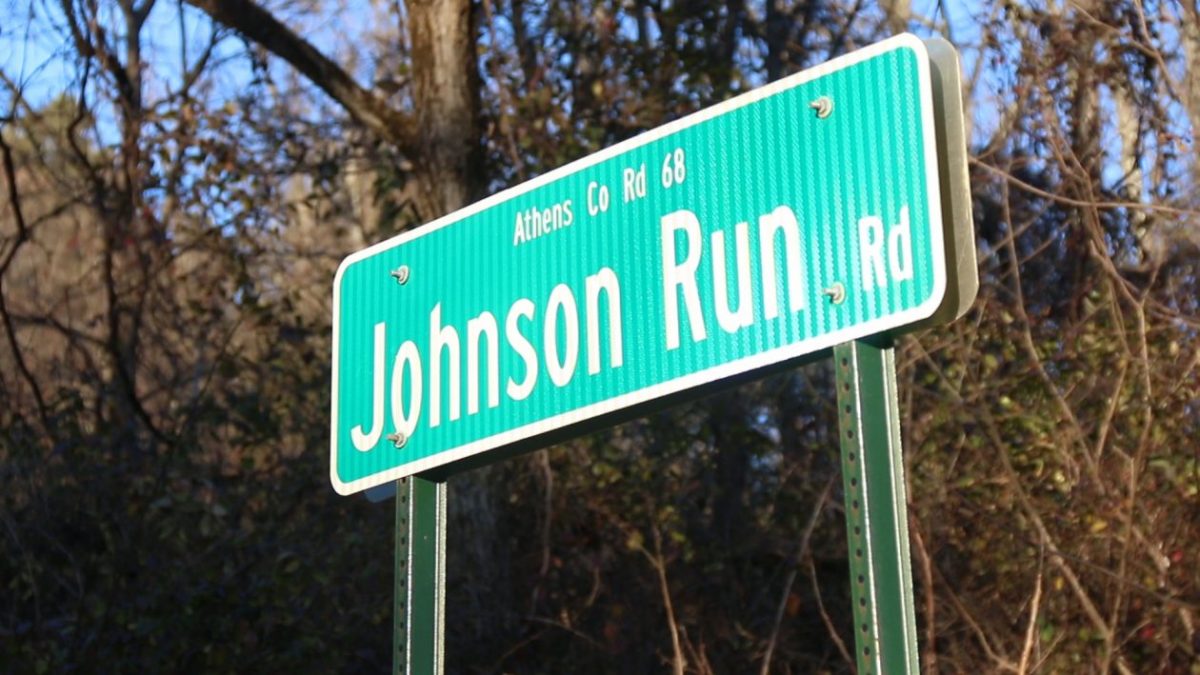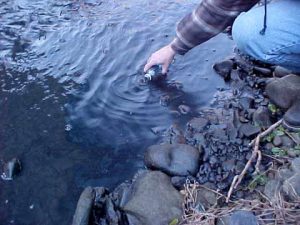
Controversial Coal: Plans for Athens County Mine get Public Pushback
< < Back toBy: Lily Bradley, Matt Cudahy, Shane Dazen
In 2017 Oxford Mining Company announced its plan for a proposed coal mine in Athens County. Almost immediately, local activists and residents criticized the plan for safety concerns and the environmental impact the mine could have on the county.
Neither the push back from the public nor setbacks in the original plan, has deterred the Coshocton-based coal company from pursuing its plans to mine the more than 300-acres.

Oxford’s Plan
In May last year, Oxford Mining Company published a proposed five-year plan for the 300-acre mine off of Johnson Run Road in Trimble Township.
The 236-page document estimates the mine would produce more than 1.15 million tons of coal through both surface and underground mining. The company estimates the new mine will generate more than $1 million in tax revenue. In addition, Oxford believes the mine would bring nearly 100 jobs to the area.
Oxford Mining Company is an Ohio-based coal company established in 1985. In 2015 Westmoreland Coal, a Colorado-based coal company, purchased Oxford. The two companies entered into a limited partnership. Westmoreland currently has 17 coal mines across the United States and Canada. Oxford’s main office is located in Coshocton. We reached out to both Oxford and Westmoreland for a comment. After multiple attempts we received a “no comment” from the company on the battle over permits and the status of the mining project.
Road Block: Controversy Over County Road Waiver
Oxford has had to follow a series of steps in its effort to gain approval for the proposed mine.
One of the first roadblocks for the mining company was getting access to 100 feet of County Road 68. Initially, Athens County Commissioners granted Oxford the right-of-way road waiver to travel Johnson Run Road, a long and narrow road that sits on the border of Athens and Perry counties.
A right-of-way road waiver would give the company the legal right to drive a specific route through property owned by someone else. The concern is coal trucks traveling this narrow road.
However, late last year Commission president, Lenny Eliason, and his fellow commissioners voted to rescind the waiver because of a mistake made by Oxford on a public notice.
“It was brought to our attention by some members in the community that there were some irregularities in the process with their advertising and their permit application,” explains Eliason. “So we investigated them.”
The initial vote to rescind happened on September 19th. One week later, Oxford filed an appeal stating the company believed the permit was rescinded unlawfully.
In December, county commissioners voted against a second road waiver — again arguing the public notice did not match the plans provided by the company.
“We still had some major concerns about the permit. Things had not been corrected for us to move on. So, we could not move forward with it,” Athens County Commissioner Charlie Adkins said.
Oxford apealed again and asked for an evidentiary hearing. But in early February, the judge denied Oxford’s appeal request.
Rough Waves: Water Permits Set Back Restoration Efforts
In the meantime, Oxford still has a water-quality permit pending with the Ohio Department of Natural Resources. We reached out to ODNR for comment but no one responded to our request for information on the status of that permit.
Another water-quality permit has already been approved, but Oxford is still waiting for the approval of an NPDES permit.

The NPDES is the National Pollutant Discharge Elimination System permit. If approved, it will allow the mine to discharge wastewater into the Johnson Run Creek.
The current proposal will affect more than 2.5 acres of wetlands and will undo progress made from a $2.5 million restoration effort in the Sunday Creek Watershed.
Michelle Shively, the Sunday Creek Watershed Coordinator, says acid mine drainage is the major mining impact to watersheds in Southeast Ohio.
“Over the last twenty years, we’ve been able to work with partners to instill acid mine drainage treatment systems that are still operating,” Shively said.
Shively is worried that the twenty years of work could be lost and forgotten.
“For me, I think it’s obvious, I do this work every day and I value the reclamation and restoration and the life that we have brought back to the stream,” Shively explained.. “If the project does go through and if they do mine in Johnson Run, I just want to be sure that every possible precaution can be taken, but I don’t want to see impacts to an area that has already been impacted.”
Local Pushback
Shively joins a long list of community members who are concerned about the possible negative impact a coal mine could have on the area.
Roxanne Groff is a founding member of Save Our Rural Environment or S.O.R.E., a grassroots group that protests the permitting of strip sines in eastern Athens County.
“Looking at the devastation and the legacy that coal mines have left in Southeast Ohio, why would we want to continue that? Fossil Fuels… we’re just over it,” Groff said.
Through S.O.R.E., Groff works closely with her friend Lorraine McCosker. McCosker is a professor at Ohio University who specializes in environmental sustainability.
McCosker believes the negative impact outweigh the potential positives.
“This coal mine certainly won’t build an economy. The impact is just far too great for what it will offer to the communities,” says McCosker. “ We really need to reclaim our communities and make them cleaner and healthier again.”
Voices Heard: EPA Public Hearing
On February 15, the Ohio EPA organized a public hearing at Burr Oak Lodge in Glouster, Ohio, after receiving pressure from the community.

The meeting began with an information session, hosted by Kristopher Weiss of the Ohio EPA’s Public Interest Center and Scott Foster, who works in the Division of Surface Water. They answered any questions about the NPDES wastewater discharge permit.
The permit is required for facilities that discharge pollutants to streams and sets discharge limits that are protective of human health and aquatic life and preventative nuisance conditions. A hearing open to public testimony immediately followed.
Among the issues addressed was the concern about the water quality in Sunday Creek should Oxford’s application be approved.
The Ohio Environmental Protection Agency maintains that the proposed project may result in a change from current water quality conditions, but does not indicate any violation of Ohio’s water quality standards that protect human health and the environment.
In the presentation, the EPA described a series of steps that must be taken before any permit is approved. In addition to the permit, the EPA requires further approval of a 401 Water Quality Certification.
The 401 certification is mandatory for projects proposing to discharge fill material into waters of the state.
Approval for Oxford’s certification was issued on September 15, 2017, so if Oxford’s application for the water-quality permit is approved, the company is nearly ready to start digging.
For the record, the state EPA says it will consider technical, economic, social and environmental aspects of the project before deciding whether to issue or deny the final permit.
Shively, McCosker, and Groff were just were just a few of the dozens of people who testified at the meeting and submitted written comments.
The deadline to submit comments passed ended February 22, leaving the EPA with the difficult task of sifting through all the comments and complaints before making a final decision.
Coal in Southeast Ohio
President Donald Trump campaigned on the promise of bringing coal jobs back to regions like Appalachia. But a year into his presidency, any success has been minimally felt — especially in Ohio.

As of December 2017, the coal industry employed more than 50,000 people across the United States.
While the U.S. gained 771 coal jobs overall last year, Ohio’s numbers went down. The state lost 414 jobs, the second highest net loss for a state last year. Coal is currently produced in 18 counties across Ohio, including Athens, Perry, Meigs, Vinton, and Jackson.
Mike Cope serves as the interim president of the Ohio Coal Association.
Cope highlighted the important economic benefits another mine could bring to the County – especially a county with an unemployment rate of more than 5 percent.
“Coal has been a huge part of the economy of Southeastern Ohio,” Cope said.
“It is not what it used to be and I recognize that,” he adds. “But the jobs we pay create a living wage, they come with benefits and that is an important part to this story.”
Fossell Fuels’ Future
The Energy Information Administration believes fossil fuels are here to stay.
At its 2018 Energy Outlook news conference, the E.I.A. predicted fossil fuels would still account for more than seventy-five percent of the United State’s energy in 2050.
Cope agrees, “The future is a great mix, of which coal will play a major part in. Invest all you want to in other sources, just don’t prevent us from being able to earn are livelihood with the amount of time and resources we have.”

